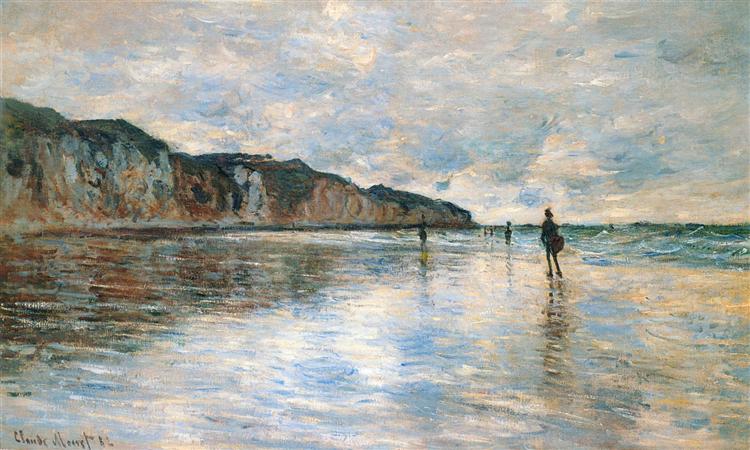Beskrivelse
Claude Monet's "Low Tide at Pourville," painted in 1882, stands as a masterful example of the Impressionist exploration of light and color. In this painting, Monet captures a fleeting moment on the coast of Normandy, where the tide has receded, exposing the sand and rocks of the seabed. This thematic choice is characteristic of the artist's approach to natural landscapes, which often required meticulous observation of the surroundings and attention to the effects of light.
In "Low Tide at Pourville," the composition is balanced through a series of layers that invite the viewer to visualize the interplay between sea, sky, and land. The horizon line is placed at the top, leaving much of the canvas occupied by beach and sea in soft, enveloping patterns that apply a loose and rapid technique. This is typical of Monet's works, where the brushstroke is visible and at times seems almost improvised, seeking to capture the essence of the moment rather than capture a precise detail.
The colour palette is another notable feature. Monet uses shades of blue and grey for the sea and sky, contrasting with the warmth of the sand tones that occupy the lower part. This choice not only evokes the weather, but also suggests an influence of light that changes constantly throughout the day, something that Monet studied in depth in his works. The atmosphere generated by his technique, combined with the soft nuances of colour, makes the viewer feel the freshness of the sea breeze and the changing atmosphere of the coast.
Along the beach, small, distant human figures can be discerned, adding to the visual narrative of the landscape. These figures, who appear to be engaged in recreational or work-related activities characteristic of the coast, allow Monet to explore the relationship between man and nature. Their inclusion, though subtle, adds a layer of life to the setting and recalls the intimacy that Impressionism sought between the subject and its surroundings.
This painting also represents a moment in Monet's career when he was establishing his style, integrating influences from Tonicism and Naturalism into a visual language that anticipates the development of his artistic maturity. Monet had visited Pourville on several occasions, suggesting his personal attachment and fascination with this specific place, where he was able to experiment and reflect on light and colour in new dimensions.
In the context of his overall oeuvre, “Low Tide at Pourville” shares similarities with other pieces that explore coastal settings, such as “The Beach at Étretat” and “The Almond Blossoms.” In all of these, Monet not only depicts landscapes, but also imbues each brushstroke with his perceptions and emotions, transforming the everyday into an object of aesthetic wonder. Through this work, one senses the essence of Impressionist painting in its purest form: an instant of calm and beauty in which nature comes to life.
KUADROS ©, a famous painting on your wall.
Hand-made oil painting reproductions, with the quality of professional artists and the distinctive seal of KUADROS ©.
Painting reproduction service with satisfaction guarantee. If you are not completely satisfied with the replica of your painting, we will refund 100% of your money.

